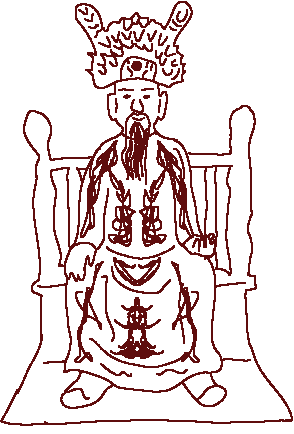
Đức Thánh Trần
Đức Thánh Trần (Saintly Lord Trần) or Trần Hưng Đạo/Trần Quốc Tuấn was a military general who lived from 1228–1300 and was responsible for stopping three major Mongol invasions led by Kublai Khan which led to Dai Viet's continued independence. If I'm not clear enough in the history section, he was responsible for coming up and executing the ideas of cutting off supply and launching raids against the Mongols.
Note that he goes by various different names, those being:
- Trần Quốc Tuấn, the name he was born with
- Trần Hưng Đạo, his military title with 'Hưng Đạo' roughly meaning 'rising path'.
- Đức Thánh Trần, his saint name with it translating to 'the virtuous saint Trần'.
Deification
After his death, Trần Hưng Đạo was made a saint in the Đạo Mẫu (Mother Goddess) tradition and people started to worship him as a patron saint (simplified but basically heavenly protector) of the military. His spirit is believed to spiritually continue to protect Vietnam by being able to scare off evil spirits.
Worship
People often offer things like nuts, leaves and swords or armor in exchange for protection. He's believed to govern his own court populated by him, his generals and his soldiers. It's a seperate spiritual realm and uses his army and generals to protect those who leave offerings.
History
He was the son of Prince Trần Liễu of the Trần Dynasty and was in his youth exposed to military theory and Confucian ideals. In 1258 the Mongols, who had previously conquered the Jin Dynasty of China giving them control over much of the north of China. But, the Mongols wanted the whole of China, meaning they would have to conquer the south aswell. So, the Mongols thought that since Vietnam was directly under China having them as a vassal would make subduing the rest of China easier since they could attack on two fronts at the same time.
Vietnam refused, mostly because the Mongols demanded that Vietnam would essentially lose all say in Vietnamese affairs as they would be handled by the Mongols, along with the facts that the Mongols would most likely use Vietnamese troops to fight for the Mongols and the Mongols' history of annexing former vassal states by force. Refusal meant invasion, and the Mongols marched through Yunnan into Vietnam.
First Mongol Invasion
The Mongols sent Uriyangkhadai, in charge of some 25-30,000 troops in January of 1258. The Vietnamese sent an army to combat the Mongol troops led by Trần Nhật Duật and Trần Quốc Tuấn were outflanked at the the Battle of Bình Lệ Nguyên resulting in Mongol victory and the loss of the battle caused Hanoi (at the time named Thăng Long) to fall under Mongol control. When they arrived, they found that the Trần family had destroyed any supplies Uriyangkhadai could've used to re-equip his army.
The two Vietnamese generals took advantage of the situation and launched a surprise attack against the Mongols, who were low on supplies and sent them running back to Yunnan by February of 1258. This victory gave Trần Hưng Đạo so much prestige he was elevated to command the entire Vietnamese army.
Second Mongol Invasion
The second invasion took place in 1285 and by now had conquered the whole of China. The Mongols again tried to make Vietnam a vassal tribunary where Vietnam would give up certain aspects of independence to appease the Mongols. Vietnam refused, and the Mongols invaded. This time, the Mongols sent a navy with some 500+ warships and more than 100,000 troops to invade the country.
Trần Hưng Đạo was in charge of the Vietnamese army and knew that a direct invasion would be stupid considering he had way less troops and when the Mongols pushed into the country he made sure to burn villages to the ground so the Mongols wouldn't be able to leech off of Vietnamese supplies. Once again, in March 1285 the Mongols entered Hanoi to find it without supply.
Vietnamese forces raided and ambushed supply lines which, from May to June, caused thousands to die of disease, starvation and heatstroke. By June-July the Vietnamese continued to launch surprise attacks, and during a certain battle of Chương Dương, Trần Hưng Đạo even managed to kill Sogetu who was the head of the Mongol navy. The Mongols left Vietnam by July.
Third Mongol Invasion
Kublai Khan, leader of the Mongol Empire, was by now sick of defiant Vietnam repeatedly giving a big fat F U to the superior Mongols. So, in 1287, Kublai sent an army of 50,000+ troops along with a naval fleet of 500+ warships and a supply fleet carrying food of more than 70 ships so the armies wouldn't starve like the last two times.
They easily marched into Hanoi, whose supplies were burned down beforehand. Trần Hưng Đạo made sure to let the Mongols chase down Vietnamese raids, thus stretching out supply. In March of 1288 during the battle of Vân Đồn, Vietnamese forces managed to destroy the Mongol supply fleet leaving the Mongols in Vietnam without any food.
Battle of Bạch Đằng
On April 9th of 1288 Đức Thánh Trần (taking inspiration from the general Ngô Quyền who employed the same tactics in 938) and his army planted hundreds of wooden stakes tipped with iron underwater at the shallow Bạch Đằng estatuary where the river met the Bạch Đằng opened into the South China Sea. The Vietnamese "retreated" during a high tide, leaving the Mongol fleet to chase after the Vietnamese. But, as they chased, the tide lowered and exposed the underwater stakes which pierced into the belly of the Mongol ships which left them stranded.
The Vietnamese shot fire arrows and let groups of soldiers board the trapped ships to capture or kill the crews. The Mongols' main navy commanders were captured and the whole ordeal caused the Mongol army in Vietnam to retreat back into China. Kublai Khan, hearing the news, gave up on integrating Vietnam altogether.